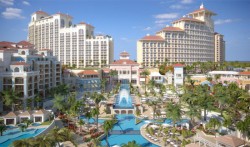Local environmentalists are claiming a victory in their fight against liquefied natural gas in the Bahamas – as the US Coast Guard suspended the approval for a LNG plant in the Gulf of Mexico because of concerns of damage to marinelife.
Margo Blackwell, an Andros based environmentalist, said that the decision is a sign that the global tide is turning.
“This is a further notice that people are becoming more environmentally conscious and don’t let developers and governments ride rough-shod over their coneerns,” she said.
The US Coast Guard has suspended the approval process for a liquefied natural gas terminal that would be built 11 miles south of Dauphin Island, in an attempt to address new concerns from federal regulators about potentially damaging effects on fish populations in the Gulf of Mexico.
“Everywhere else in the world people are taking notice, they are realising that nature is a resource that can’t be restored. Only here they continue to hack away at the environment,” Mrs Blackwell said.
She encouraged Bahamians to speak out against the proposed LNG projects for Ocean Cay and Grand Bahama.
According to an Associated Press Report a letter written by the US Environmental Protection Agency in April insists that the Coast Guard review the possibility that fish numbers in Alabama and Mississippi waters would be hit especially hard by the use of 50 billion gallons of sea water each year.
Using sea water to warm the gas will save LNG companies between $20 million and $40 million a year, according to an Environmental Impact Statement for another terminal proposed offshore of Louisiana.
The US based National Marine Fisheries Service has previously performed that calculation, and found that the terminal could wipe out 25 per cent of the annual redfish harvest in both states. Other species, including crabs and shrimp, could be similarly affected, according to fisheries scientists.
The EPA letter also raised the issue of a large and muddy sediment plume that would be generated by the terminal’s use of sea water.
The plume, which is expected to extend about five miles from the facility, had escaped the attention of many state and federal officials. Mud and sand on the sea floor would be disturbed and spread into the water column by the 150 million gallons of water expelled from the termial each day during operation.
The plume would be about 25 times muddier than the Missisippi River, according to data in the Compass Port impact statement and hydrological studies detailing the river’s average sediment load.
Last week it was revealed that the Bahamas could see not only one, but two LNG terminals built in the country in the near future.
With negotiations for an agreement between government and the AES Corporation nearing completion, and Suez Energy North America still pushing for a LNG facility in Grand Bahama.
The need for energy in Florida is expected to double within the next 15 to 20 years and some observers have said that it could very well be that government would approve more facilities in the Bahamas.
Florida currently only has one source of natural gas, which is transported through a pipeline from New Orleans and the state is in desperate need of a second source to service the constantly increasing demands for energy.
Should Florida’s demand increase, it would make more sense for AES to add another pipeline to its facility, as opposed to building an entirely new LNG terminal.
However should Suez (formerly Tractebel) North America meet all the necessary requirements in the future, there is still the possibility that it may be allowed to build a terminal at the proposed Freeport Harbour location.
By RUPERT MISSICK Jr, Chief Reporter, The Tribune



